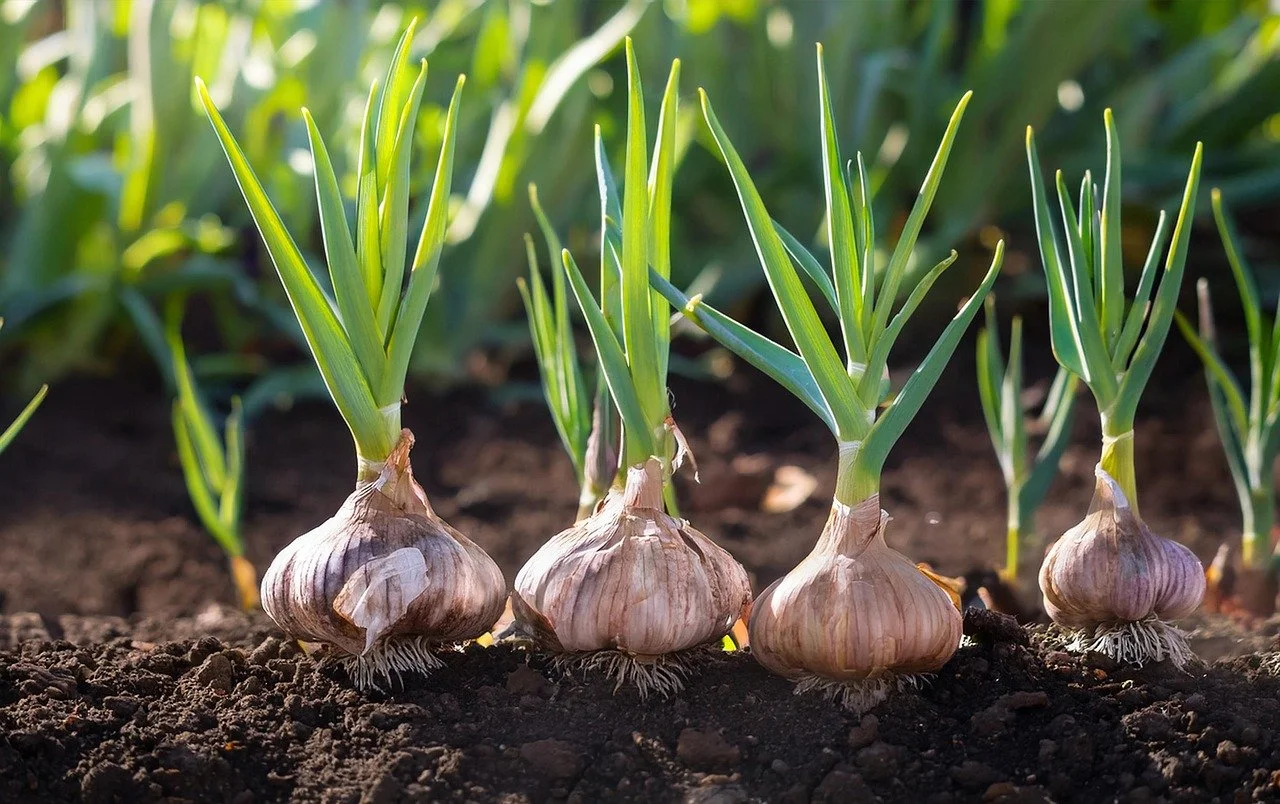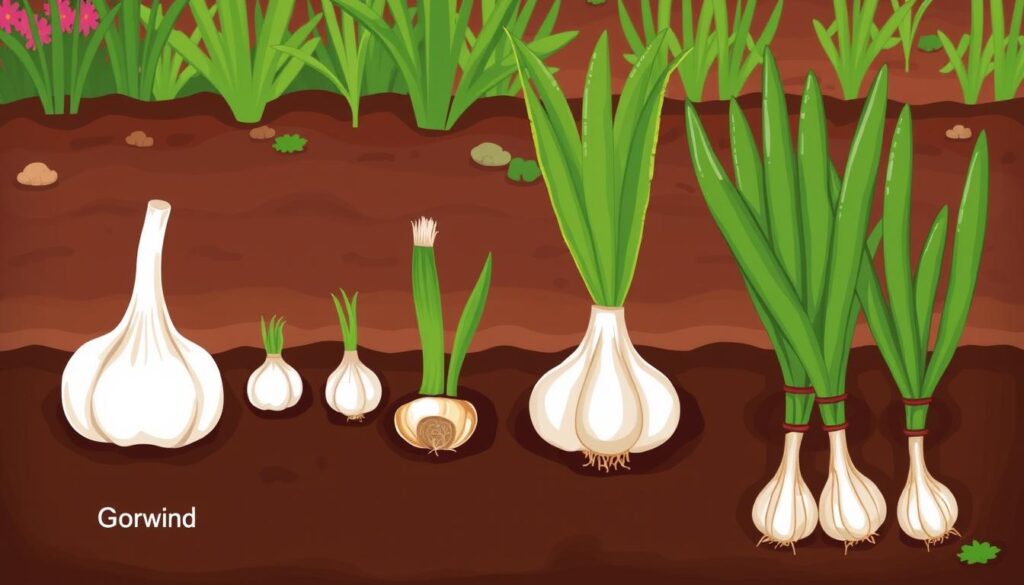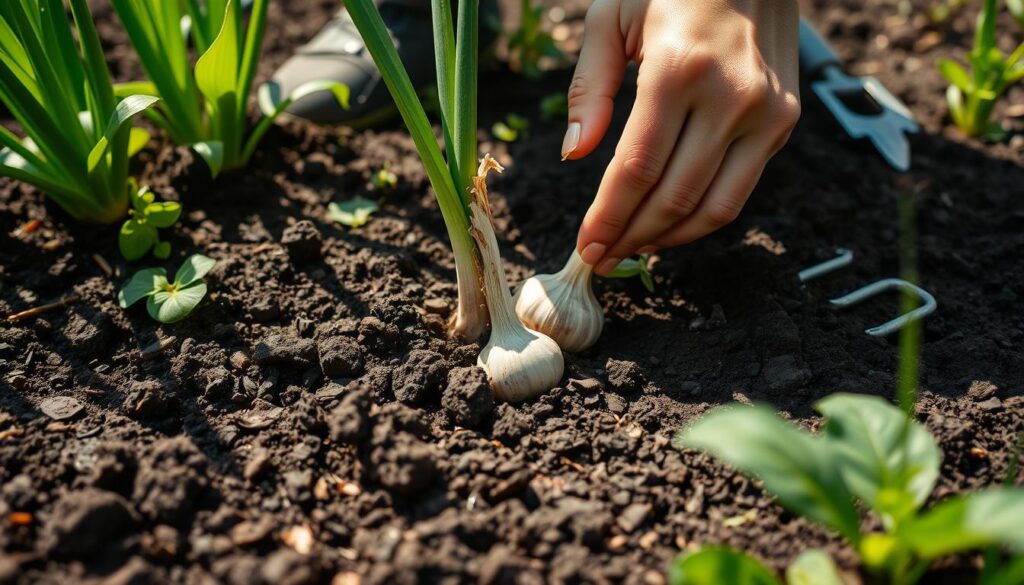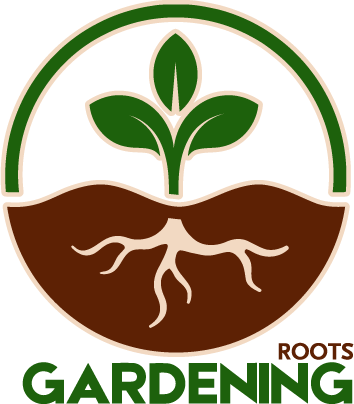Table of Contents
Do you remember the last time fresh garlic made your dish taste amazing? Growing garlic in your backyard can do the same. It’s not just about better food; it’s about the joy of watching a small clove grow into a big harvest. For many gardeners, growing garlic is a special journey that connects them with nature through delicious food.
Are you curious about picking the right garlic or learning how to plant it? This guide covers everything from growing garlic indoors to harvesting and curing. Each step is a chance to get closer to your garden.

Garlic is tough and versatile, and it loves the right conditions. It gives back with its amazing taste and health benefits. As you start growing garlic, you’ll see how each step is important for a great harvest. It’s a rewarding part of gardening that keeps you learning and enjoying.
Key Takeaways
- Understanding why garlic is a rewarding and beneficial crop to grow.
- Learning about the importance of choosing the right garlic variety for your region.
- Knowing the detailed steps for planting garlic, including spacing and soil preparation.
- Gaining insights on garlic care and maintenance to ensure a healthy crop.
- Mastering the best practices for harvesting and curing garlic to maximize storage life.
- Avoiding common mistakes that can hinder the growth of your garlic plants.
- Exploring creative uses for homegrown garlic in your culinary creations.
Choosing the Right Garlic Variety
Choosing the right garlic variety is key for a good harvest. Knowing about garlic growing stages and climate needs helps you pick wisely.

Hardneck vs. Softneck
Garlic comes in two main types: hardneck and softneck. Each type grows differently and tastes unique:
- Hardneck Garlic: Hardneck garlic is loved for its strong taste and does well in cold weather. It has a flower stalk, or “scape,” that’s good for cooking. Music and Spanish Roja are examples.
- Softneck Garlic: Softneck garlic grows better in warm weather and lasts longer. It’s great for making garlic braids. California Early is a popular choice.
Climate Considerations
Think about your local climate when growing garlic. Hardneck varieties are best for cold places, while softneck types work better in warm areas. Knowing your local weather is important for growing garlic well. Check your frost dates and average temperatures to guide your choice.
Popular Garlic Varieties
Choosing a variety depends on your climate and taste preferences. Here are some favorite garlic types:
| Variety | Type | Climate Suitability | Distinct Features |
|---|---|---|---|
| Music | Hardneck | Cold | Strong flavor, large cloves |
| Spanish Roja | Hardneck | Cold | Rich flavor, easy peeling |
| California Early | Softneck | Warm | Mild flavor, long shelf life |
How to Plant Garlic
Planting garlic is key in gardening. Follow these steps for a great harvest and healthy growth.
Preparing the Soil
Before planting garlic, prepare the soil first. Garlic loves fertile, well-draining soil. Start by loosening the soil to 12 inches deep, removing rocks or debris.
Enhance soil quality by mixing in compost or well-aged manure. Maintain a soil pH level between 6.0 and 7.0 to support optimal growth.
Spacing and Depth
Spacing and depth are critical when planting garlic. Place cloves in the soil with the pointed tip facing upward, about 2 inches deep. Ensure 4–6 inches of spacing between each clove to allow room for bulb development.
This spacing helps with airflow and disease prevention.
When to Grow Garlic
The timing for planting garlic is crucial to ensure a healthy, robust harvest. In most areas, garlic is planted in the fall, typically 4–6 weeks before the ground freezes. This allows the cloves to establish strong roots before entering winter dormancy. For milder climates where freezing isn’t a concern, planting in early spring is also an option, although fall planting generally produces larger bulbs.

To better understand when to plant garlic in your area, refer to this seasonal guide:
Seasonal Garlic Planting Guide
| Region/Climate | Planting Season | Key Tips |
|---|---|---|
| Northern U.S. (Cold Climates) | Late September–October | Choose hardneck varieties like Music or German White. Add mulch for winter protection. |
| Southern U.S. (Warm Climates) | October–November | Opt for softneck varieties like California Early. Ensure soil remains moist but well-drained. |
| Milder Coastal Regions | October–February | Hardneck and softneck garlic both thrive. Avoid planting in overly wet soil. |
| Tropical/Subtropical | Late Fall to Early Winter | Select softneck varieties. Provide partial shade and water consistently to prevent overheating. |
| Mountainous Regions | Early Fall | Plant early to establish roots before the ground freezes. Use a thick mulch layer. |
| Mediterranean Climates | Late Fall to Early Winter | Softneck garlic performs best. Ensure soil drains well to prevent bulb rot during wet winters. |
By aligning your planting schedule with your region’s climate, you give your garlic the best chance to thrive. Remember to also check your local frost dates and average temperatures to fine-tune your timing.
Garlic Care and Maintenance
Keeping your garlic healthy needs careful attention and regular upkeep. Whether you grow it in the ground or in containers, consistent care leads to a great harvest. Here’s a detailed guide to help your garlic plants thrive:
Watering Garlic
Garlic thrives in moist but well-drained soil. Water deeply once a week, ensuring the soil dries slightly between watering. For container-grown garlic, monitor the soil more frequently as it tends to dry out faster. Avoid waterlogging, which can lead to root rot.
Fertilizing Garlic
During early growth, garlic benefits from a nitrogen-rich fertilizer to encourage strong leaf development. As bulbs begin to form, switch to a phosphorus-rich fertilizer to support bulb growth. Feed plants every 3–4 weeks for optimal results.
Managing Pests and Diseases
Keep an eye out for common garlic pests such as:
- Aphids: Use neem oil or insecticidal soap to treat the infestation effectively.
- Onion Maggots: Prevent infestations by rotating crops and using protective netting.
For diseases like rust or white rot, maintain good air circulation by spacing plants adequately and removing any infected foliage promptly.
Mulching for Weed Control
Spread a layer of organic mulch, like straw or shredded leaves, around your garlic plants to retain moisture and suppress weeds. Mulch helps retain soil moisture, regulate temperature, and suppress weed growth, which can compete for nutrients.
Here’s a quick table with key garlic care and maintenance points:
| Aspect | Recommendations |
|---|---|
| Watering | Deep watering once a week; adjust for containers |
| Mulching | Use straw or shredded leaves |
| Fertilization | Nitrogen early on, phosphorus during bulb formation |
| Pest Control | Neem oil, inspect plants regularly |
| Disease Control | Good air circulation, prompt removal of affected plants |
By following these growing garlic maintenance tips, you’ll grow strong and tasty garlic. Whether in the ground or in containers, regular care keeps your garlic healthy and productive all season.
Harvesting and Curing Garlic
As your garlic grows, you’ll need to know when to harvest for the best flavor and longest shelf life. Recognizing the garlic harvesting signs is key to a high-quality yield.
Identifying Harvest Time
Look for yellowing and browning lower leaves with green upper leaves. When three to four leaves turn brown, it’s time to harvest.
Proper Harvesting Techniques
To harvest garlic without damage, loosen the soil around each bulb with a garden fork. Be careful not to pierce the bulbs. Pull the garlic gently by the base of the plant.
After pulling, brush off dirt but don’t wash the garlic. Moisture can cause it to spoil faster.
Curing and Storing Garlic
After harvesting, curing and storing garlic is next. Hang the plants in a warm, dry area with good air for two to three weeks. This dries the bulbs and toughens the skin for long storage.
Keep the garlic away from direct sunlight during curing.
| Garlic Variety | Type | Flavor Profile | Planting Time | Harvest Time |
|---|---|---|---|---|
| Softneck – Silverskin | Softneck | Mild, long storage life | Fall | Late Summer (July-August) |
| Softneck – Artichoke | Softneck | Mild and slightly spicy | Fall | Mid-Summer (June-July) |
| Hardneck – Rocambole | Hardneck | Rich, robust, easy to peel | Fall | Early Summer (June) |
| Hardneck – Purple Stripe | Hardneck | Sweet and mild when roasted | Fall | Early to Mid-Summer (June-July) |
| Hardneck – Porcelain | Hardneck | Bold, spicy | Fall | Mid-Summer (July) |
| Elephant Garlic | Not true garlic (leek family) | Mild, sweet | Fall or Spring | Late Summer (August) |
Once dried, trim the roots and cut the stem to an inch above the bulb. Store garlic in a cool, dark, dry place for months. Proper storage keeps garlic fresh for your cooking needs all year.
Common Garlic Growing Mistakes
Growing garlic can be rewarding, but many mistakes can stop you from succeeding. One big error is planting garlic at the wrong time. In most of the United States, the best time to plant is in the fall, around October. Planting too early or late can make the bulbs smaller and affect their growth.
Soil preparation is another common problem. Garlic likes well-drained, loose soil that’s rich in organic matter. If the soil isn’t right, the roots won’t grow well, and the cloves will be smaller. Knowing the garlic cultivation tips is key for gardeners.
Overwatering is a big mistake too. Garlic needs moisture, but too much can rot the bulbs. It’s important to check the soil moisture and make sure it drains well.
Not removing garlic scapes can also hurt bulb size. Garlic scapes are flowering stalks produced by hardneck garlic varieties. Taking them off helps the plant focus on growing bigger bulbs.
Pests and diseases can also harm your garlic. If you ignore signs of trouble, your crop can be ruined. Regular checks and preventive steps can help keep these problems away.
| Garlic Growing Mistake | Impact |
|---|---|
| Incorrect Planting Time | Reduces bulb size and maturation |
| Improper Soil Preparation | Poor root development and smaller cloves |
| Overwatering | Causes bulb rot |
| Neglecting Scape Removal | Smaller bulb size |
| Ignoring Pests and Diseases | Crop devastation |
Knowing about these mistakes and using the right garlic cultivation tips can help you grow a healthy crop. Growing garlic well takes care and attention, but the results are worth it.
Garlic in Small Spaces: Container Gardening
If you’re short on space or dealing with poor soil conditions, growing garlic in containers is a perfect solution. This method allows you to enjoy fresh, homegrown garlic even if you only have a patio, balcony, or sunny windowsill.
Choosing the Right Container
- Size and Depth: Use a container at least 12 inches deep to support garlic’s root system. A wider container can accommodate multiple cloves, with 4–6 inches of spacing between each.
- Material: Terracotta, ceramic, or plastic containers are ideal, as long as they have drainage holes to prevent waterlogging.
Soil and Planting Requirements
- Soil Type: Opt for a light, well-draining potting mix enriched with organic compost. Avoid heavy garden soil, which can retain too much water.
- Planting Depth: Plant individual garlic cloves 2 inches deep with the pointed side up, maintaining proper spacing.
Watering and Feeding
- Watering: Containers dry out faster than garden beds, so water regularly to keep the soil evenly moist. Avoid overwatering to prevent bulb rot.
- Fertilizing: Feed your garlic with a nitrogen-rich fertilizer during the initial growth phase, switching to a phosphorus-rich formula as the bulbs develop.
Sunlight Needs
- Garlic thrives with 6–8 hours of direct sunlight daily. If growing indoors, position the container near a south-facing window or use a grow light to mimic natural sunlight.
Cold Weather Protection
In colder regions, outdoor containers need extra insulation to protect garlic roots during winter:
- Wrap pots in burlap or bubble wrap.
- Add a thick layer of mulch to insulate the soil.
Alternatively, move the container to a sheltered location, such as an unheated garage or a covered porch.
Harvesting and Storage
Garlic grown in containers matures within 6–9 months. Start garlic harvesting when the leaves start to dry out and be yellow. Cure and store the bulbs in a cool, dark place for long-term use.
Growing garlic in containers is a rewarding experience for gardeners with limited space. With proper care, you can enjoy fresh, flavorful garlic all year round!
Conclusion
Growing garlic in your garden is more than just cultivating a crop—it’s an opportunity to connect with nature, enhance your self-sufficiency, and create something truly rewarding. Whether you’re growing garlic in a backyard bed or a sunny windowsill container, the process teaches patience, care, and a deeper appreciation for the food you eat.
From selecting the perfect variety to nurturing it through each growing stage, every step is a chance to learn and grow alongside your plants. Garlic is a symbol of resilience and versatility, thriving with the right balance of care and nature’s touch.
Homegrown garlic isn’t just fresher and more flavorful—it’s also a step toward sustainable living. By growing your own, you reduce reliance on store-bought produce, cut down on waste, and embrace gardening practices that benefit both you and the environment.
So, get started today! Experiment, make mistakes, and celebrate your successes. With time and care, your garden will reward you with garlic that’s bursting with flavor and nutrition—perfect for your kitchen and your lifestyle. Happy gardening!
FAQ
How long does it take for garlic to grow?
Garlic takes about 6 to 9 months to grow from a clove to a mature bulb. This time can change based on the garlic type and the weather.
What are the key garlic growing stages?
Garlic goes through several stages: planting, germination, growth, bulb formation, and harvesting. Knowing these stages is key to growing garlic well.
How do you grow garlic from a bulb?
To grow garlic, separate the cloves from a bulb. Plant them in soil with the pointed end up. Make sure they’re spaced right and planted deep for the best growth.
When is the best time to grow garlic?
Fall is the best time to plant garlic, letting it grow roots before winter. But, you can also plant in spring if your area has a milder climate.
Can you grow garlic in containers?
Yes, you can grow garlic in containers. The container must be deep for roots and have good drainage. Use a good potting mix for the best results.
How do you grow garlic indoors?
To grow garlic indoors, plant cloves in a pot with well-draining soil. Place the pot in a sunny spot and keep the soil moist but not too wet.
Can you grow garlic in water?
Yes, you can grow garlic in water. Just put a clove in a small container with shallow water. Keep the water fresh and the container sunny.
